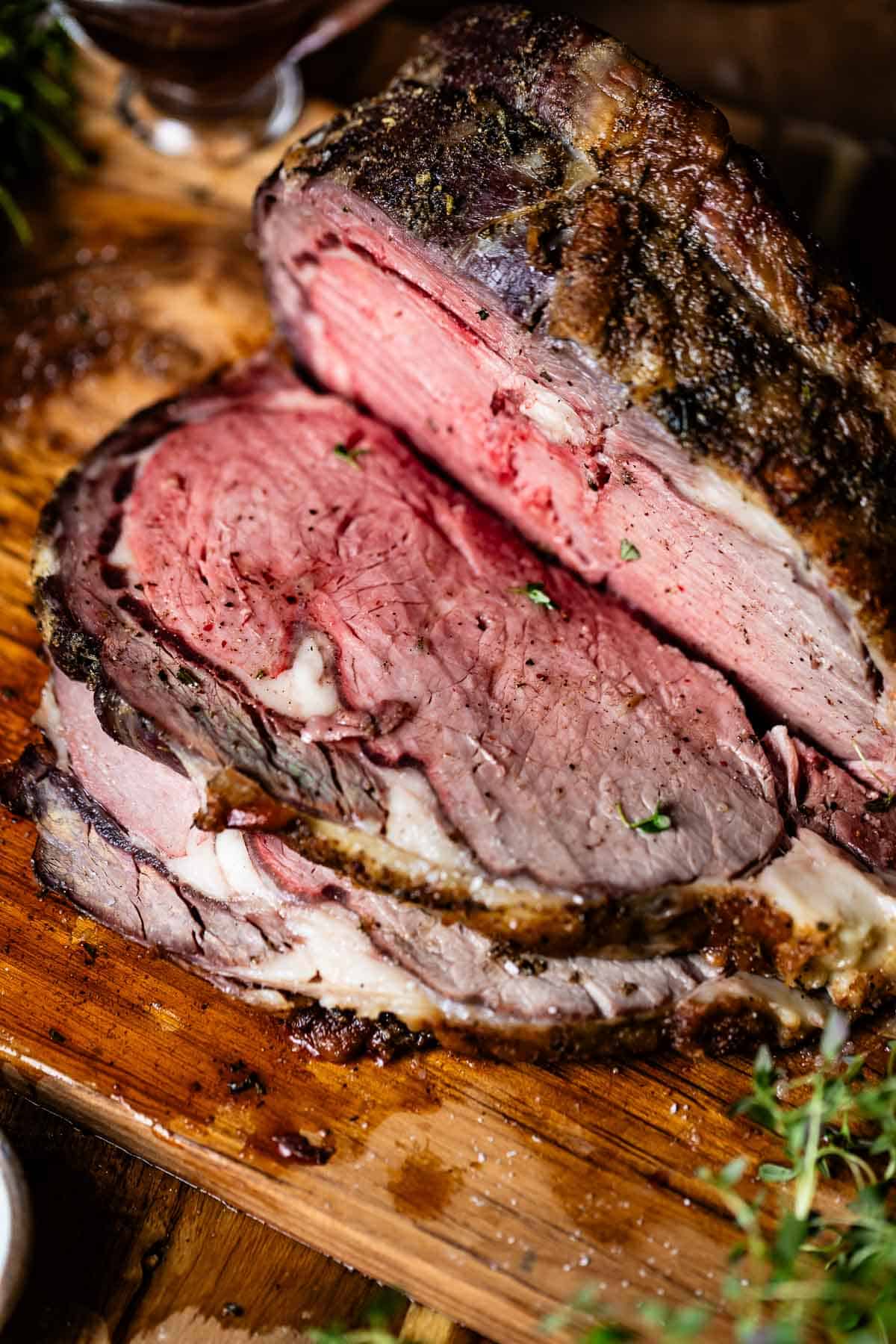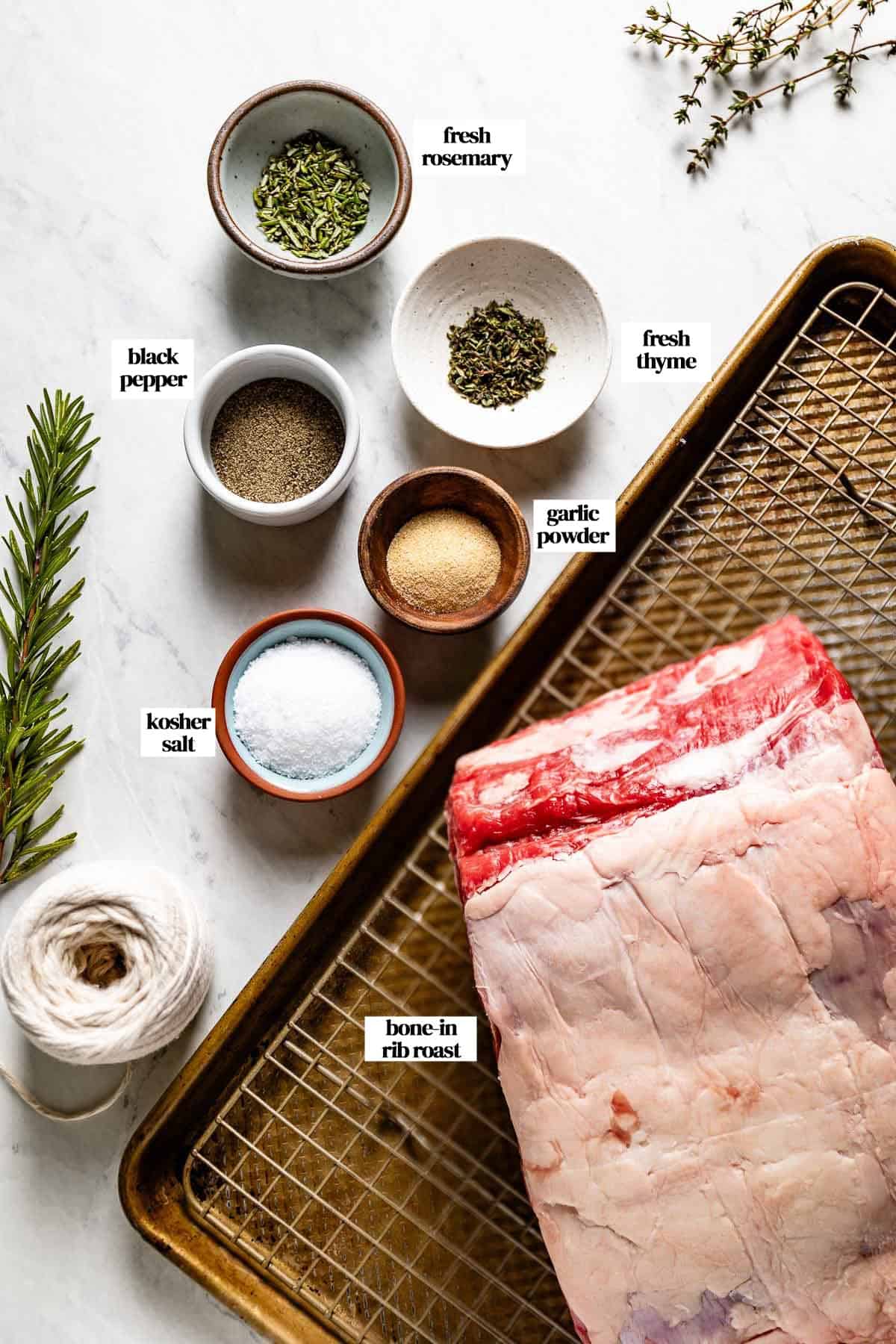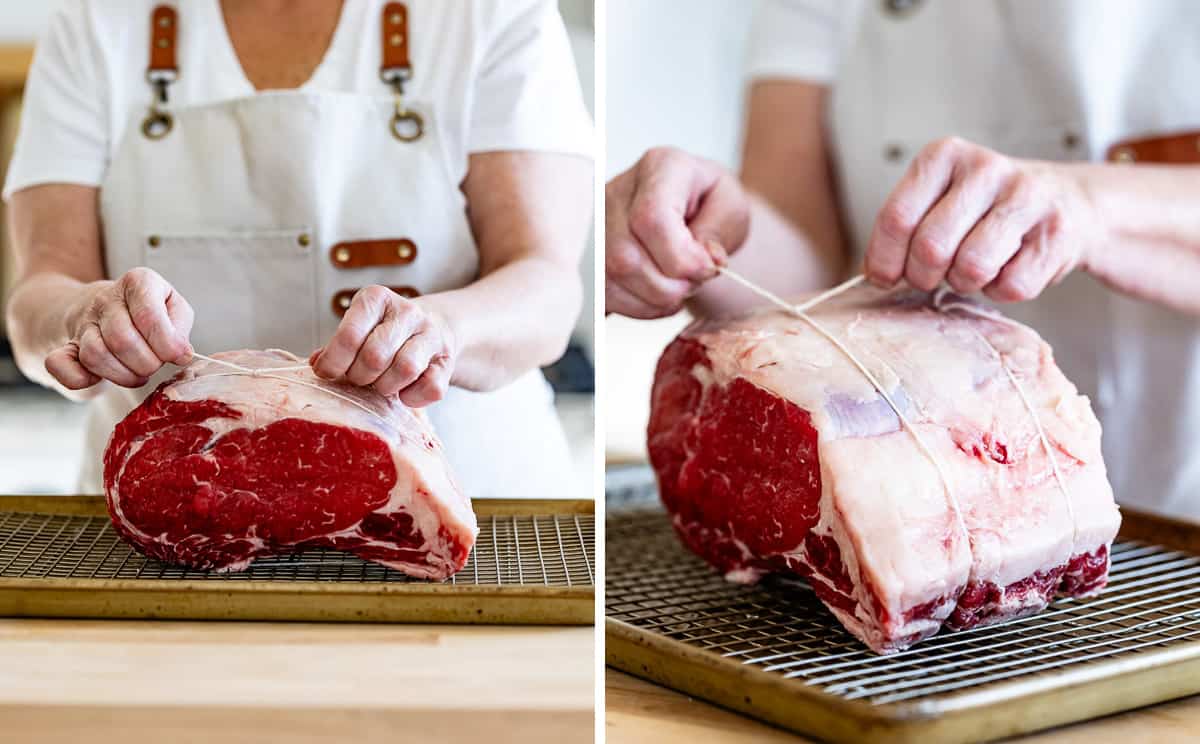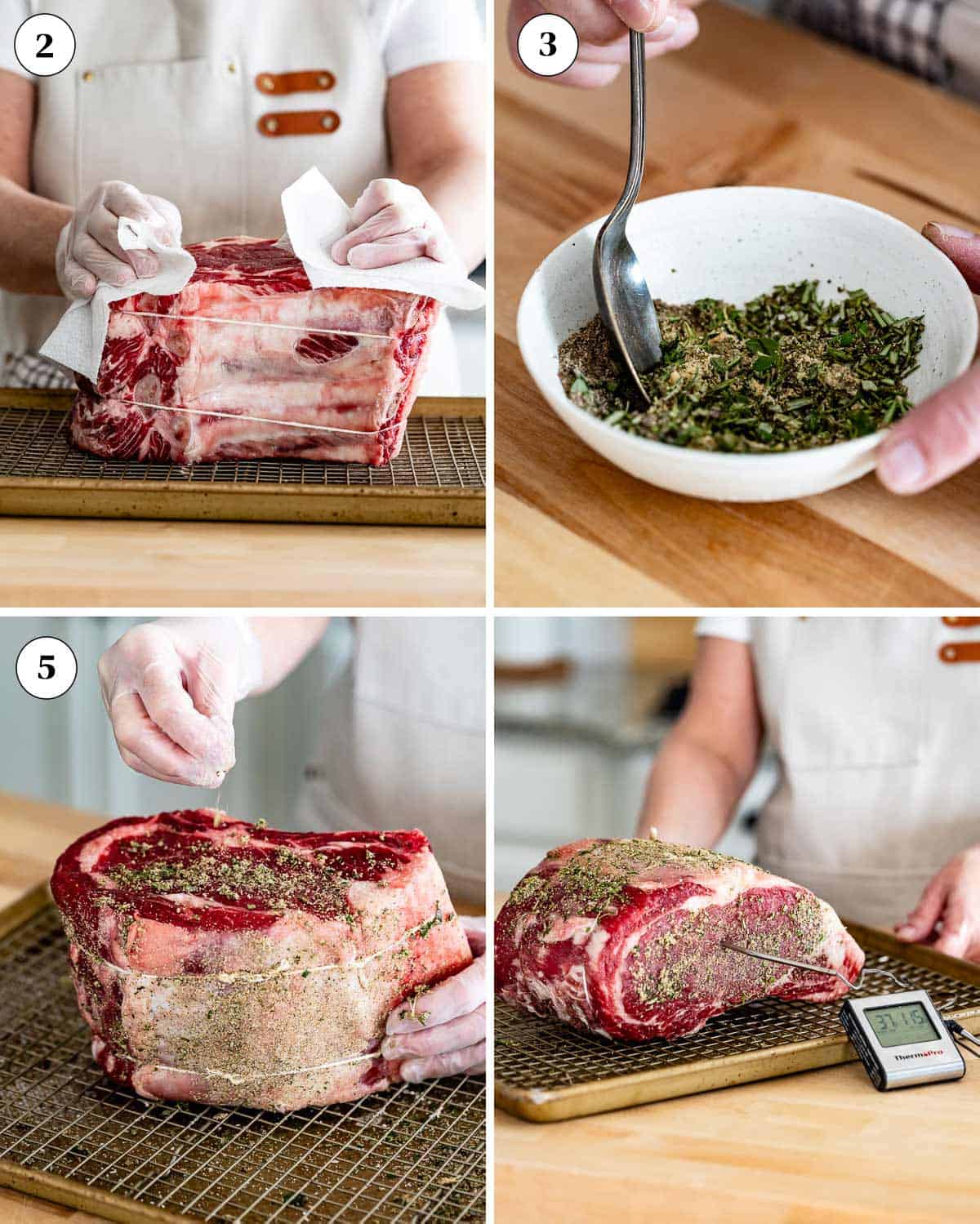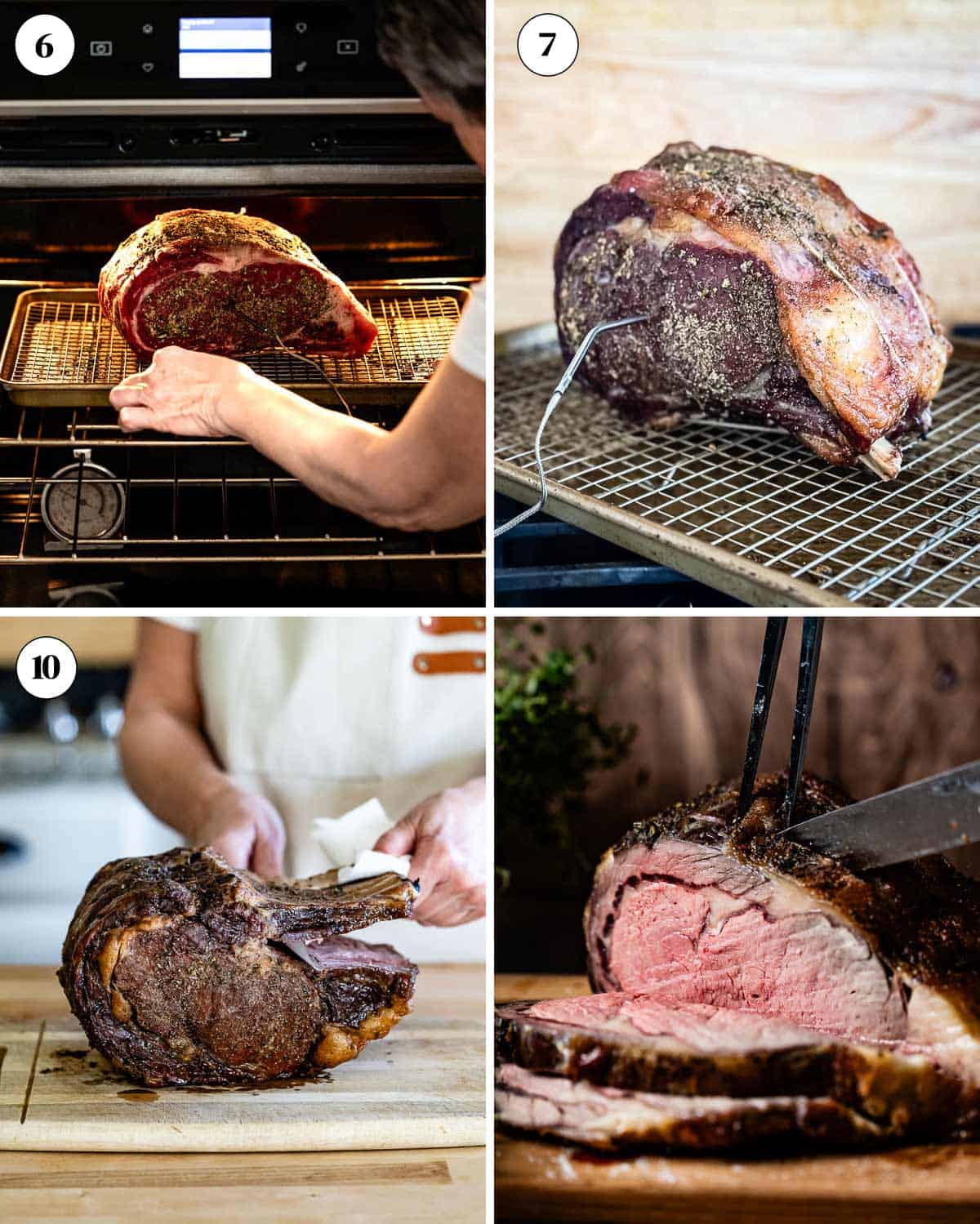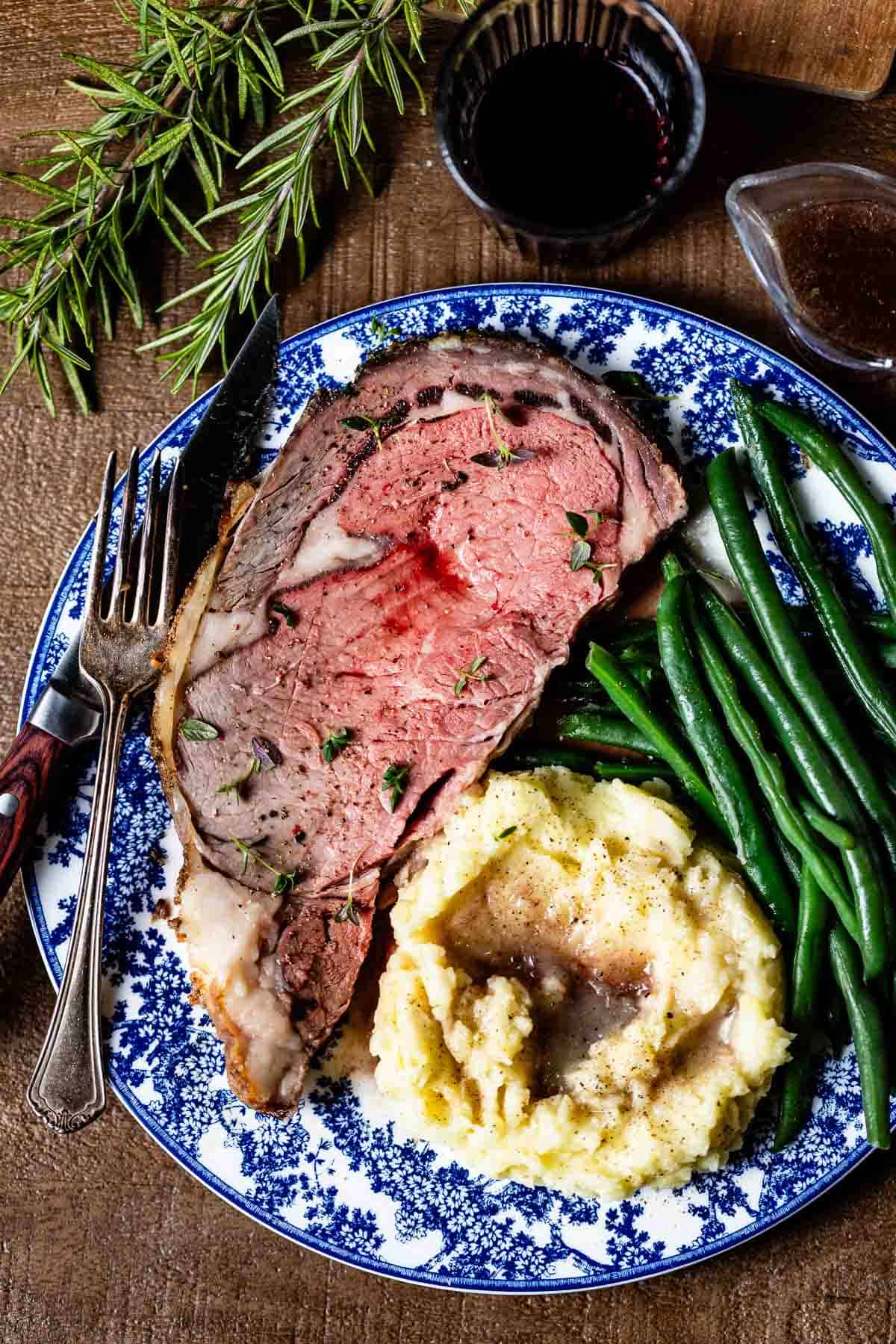We can personally vouch that reverse-searing—a technique popularized by chef Kenji López—is hands-down the best cooking method to use if you want your beef to come out as succulent, tasty, and effortless as possible. Below, I’ve listed just a few of the many reasons why:
Even cooking: Unlike traditional cooking techniques, reverse searing prime rib in the oven results in more uniformly cooked meat, eliminating the gray outer ring of meat and inner rawness you might otherwise run into. Instead, the low-and-slow method cooks the beef’s center and edges at the same rate, ensuring the entire interior reaches your desired temperature before searing the outer edge. Better texture and flavor: Buttery, rich, and lined with a heavenly crust, this reverse sear prime rib recipe has a much juicer, softer texture than other preparation methods can yield. These ideal results happen because reverse searing allows the beef’s fibers to break down slowly as the fat’s moisture is released into the meat, ensuring every inch has maximal tenderness and flavor. Better control over the doneness: When you make a low and slow prime rib, there’s less pressure to time your roast down to the second. Cooking your meat at a lower temperature for longer ensures you have larger windows to achieve your ideal internal temperature, taking the stress out of timing. The perfect crust with the most tender meat: Making reverse-seared prime rib roast is a foolproof way to get an ideal balance of tender internal meat and flavorful crusted edges. Cooking prime rib slowly ensures its insides become perfectly tender while the final high-temperature sear melts the roast’s external fat, creating an outer layer of savory, caramelized, and deliciously crusty meat. No need to rest: Most often, roasted beef must rest after cooking, taking at least 30 minutes to cool before you can carve. However, reverse seared prime rib doesn’t need all that extra resting time. Instead, the meat has time to rest as it reaches your preferred internal temperature, letting you enjoy its juicy goodness the moment it comes out of the oven.
Prime Rib
Prime rib—also referred to as “rib roast,” “standing rib roast,” “ribeye roast,” and “prime rib roast”—is one of the most savory, versatile cuts of beef. That’s why this roast recipe is so luxurious: because it needs so few added flavors to achieve the most succulent, mouthwatering taste. As we were developing this recipe, we used a 7-pound bone-in prime rib, but this recipe would work with smaller or larger sizes as well. As you can imagine, there is a direct correlation between the cooking time and the size of the meat. Below you will find a helpful reverse sear roast time chart to help you determine the time of cooking based on the weight of your beef. Additionally, since prime rib is such a high-quality and expensive cut of beef, we wanted to share a few helpful tips as you select and prep your beef to ensure that you get the most bang for your buck:
Types of prime rib: When looking for prime rib, we suggest purchasing either “prime” or “choice.” Prime cuts are the more expensive of the two, but they have more marbling—a critical factor in the beef’s overall flavoring. We buy my prime rib from Whole Foods or Costco, both of which often carry prime or choice cuts. Look for heavy marbling: Much of the flavor of this oven seared prime rib recipe comes from its intermuscular fat—also known as “marbling”—as it keeps the meat flavorful and moist during roasting. The USDA rating, Prime, Choice, or Select, goes hand in hand with the amount of marbling, with more marbling being higher grade and cost. So, when searching for the perfect prime rib, look for cuts that are well-marbled rather than red throughout. The fat layer on top: Also known as the prime rib’s “fat cap,” the layer of fat that lies across the top is vital to protecting the beef as it cooks, and it lends the dish more decadent flavors as it melts into the meat’s fibers. Still, if desired, you can ask your butcher to trim the fat as long as a fair amount of the cap remains. Bone-in vs. boneless roast: When possible, we prefer cooking a whole prime rib roast—including the bones. Not only does bone-in prime rib look extra fancy, but the bones are also great insulators, helping the beef cook more evenly at both low and high temperatures. Furthermore, the bones help keep the meat upright in the oven, with the fat cap facing up. However, boneless prime rib would also work for this reverse-sear recipe.
Tying: Tying your prime rib with butcher’s twine is essential when preparing your beef cut, helping maintain its shape for even cooking and keeping the bones intact throughout the cooking process. Though you can ask your grocery butcher to do it for you, you can also tie the meat yourself. Simply line up your string at the center of your prime rib so that it lies between the innermost bones. Then, wrap the string around the body of your meat and double-knot it close to the flesh. From there, you can tie 2-4 more strings (depending on the size and weight of your ribeye roast), moving outward from the beef’s center until you secure the entire cut in a uniform shape. Frenched prime ribeye: Another popular way to prep a prime rib is by slicing it in a “Frenched” fashion, which you can ask your butcher to do for you. However, if you prefer to do it yourself, you’ll need to slice off any meat and fat at the lower 1-2 inches of the bone. This preparation method results in a sophisticated presentation and makes it easier to locate good slicing spots when carving your meat. The Cost (Look for the sale): Due to its luxurious taste and high demand, prime rib tends to be the most expensive cut of beef, ranging from $11 to $20+ per pound. However, it tends to go on sale during the holidays, making it a no-brainer for large seasonal get-togethers.
Kosher salt: We prefer Diamond kosher salt (affiliate link) due to its coarse yet delicate texture and mild flavor. If you use Morton kosher salt—which has a more concentrated flavor—We recommend using half the amount to avoid over-salting your beef. Black pepper Fresh thyme and fresh rosemary: Herby, light, and earthy, these fresh herbs help brighten the succulent richness of prime rib roast. If you prefer a dried version, we suggest using half the amount due to their more potent flavors. Garlic: Garlic powder helps give this reverse roast prime rib an extra layer of bold, savory taste. Though you can use fresh garlic instead, remember that it will be harder to distribute evenly across your beef’s exterior, and it’s more likely to burn while roasting your beef (especially during the final searing.)
Sheet pan fitted with a wire rack: If possible, we recommend cooking your reverse sear ribeye roast on a wire rack fitted over a sheet pan. The holes in the rack will help circulate the hot air, allowing the meat to cook more evenly and letting any drippings fall from the meat and into the pan. If you don’t have this equipment, though, don’t worry! You can also roast your prime rib on a baking sheet or a V-rack roasting pan. A meat thermometer: Because timing is essential when roasting your prime rib, we highly suggest using a probe thermometer (affiliate link), as it will alert you exactly when the beef reaches your preferred temperature. However, if all you have is an instant-read thermometer, you can still get good results following the timing guide we share in the temperature chart below.
Remember, too, that prime rib will undergo carry-over cooking after you remove it from the oven following the final searing at 550 degrees F., increasing its internal temperature by 5-10 degrees F. while resting. Use the below temperature chart to help you cook your prime rib to your preferred doneness. The second column represents the temperature you remove your prime rib from the oven after the initial searing at 250 °F. The third column represents the final temperature after it is rested for 30 minutes and seared in the oven at 550 °F for 5 minutes. For example, if you want a perfect medium rare prime rib, remove your beef from the oven when it reaches an internal temperature of 115 degrees F. While resting, the meat’s temperature will increase to 125 to 130 degrees F., giving you a juicy, pink center after the final roasting. Keep in mind, however, that these are only approximate times. How long you roast your beef may change depending on your desired level of doneness and the temperature of your meat before putting it in the oven. To ensure these factors affect your roasting as little as possible, let your prime rib rest for at least two hours before putting it in the oven.
Store: When storing prime rib, first let it come down to room temperature. Once cooled, store it in an airtight container in the refrigerator for up to three days. Reheat: To reheat sliced prime rib, place it in a low-temperature oven (about 300 degrees F.) until warmed through. The heating process should take around 5-7 minutes, though the timing will vary depending on the thickness of your slices and how you like the doneness of your prime rib. No matter your personal preference, be sure to keep a close eye on your meat, as the heating process happens quickly. Freeze: If you want to freeze your prime rib for future use, we highly recommend doing so without slicing the beef to protect against freezer burn and retain as much juice as possible. Let your prime rib come to room temperature after cooking, and wrap it tightly in plastic wrap as further protection against freezer damage. You can then store your wrapped meat in the freezer for up to a month and thaw it in the fridge overnight when ready to eat.
Once you have your meat ready, these tasty additions are guaranteed to take your spread to the next level, lending it smooth, savory, and bright flavors.
Sauces: Reverse cooking prime rib ensures that your meat tastes so delectable that it doesn’t need any additions to impress your table. However, you can still enhance its flavors by drizzling your sliced prime rib with a bold yet creamy horseradish sauce or savory Prime Rib Au Jus. If you prefer a smoother, richer topping, you can also prepare a Roasted Garlic Butter Sauce or simple Beef Gravy for extra creamy decadence. Vegetable side dishes: You can’t go wrong with a classic when planning a menu around reverse sear bone in prime rib. Garlic Rosemary Mashed Potatoes are luxuriously creamy and full of herbaceous notes, while Garlic Butter Green Beans will brighten up your plate with a tender-crisp flavor and gorgeous green color. For a sweeter take on traditional veggie sides, my Maple Roasted Carrots have a soft, caramelized taste that expertly balances the savoriness of roasted beef.
Bone in or boneless? You can make this recipe with or without the beef bones. However, we recommend leaving the bones in, as they help regulate temperature while cooking, giving you more medium-rare meat than you might get without them. Furthermore, bones help maintain the prime rib’s shape, helping it stay in the same position during the roasting process. Should I tie the meat? Whenever possible, we highly recommend using tied beef when oven searing prime rib—something you can ask your local butcher to do when buying your meat. Tying the prime rib between its bones will help hold the meat together, keeping the bones from falling out and ensuring even cooking during the roasting process. Salt the night before: The best dry brine for prime rib comes together with a single, simple ingredient: kosher salt! Though we recommend salting the exterior of your beef 24-48 hours before cooking, if you’re short on time, you can let it sit for at least one hour. This salting, in turn, will help give your beef a better browning as it absorbs some moisture from the exterior of your meat. A meat thermometer is a cheap investment that will pay dividends: A meat thermometer with a probe is the most important tool when roasting a perfectly tender cut of meat. This $25 simple kitchen gadget (affiliate link) will help you make informed decisions about cooking time without the mishaps of simply eyeballing your meat during the cooking process. Don’t skip resting in the middle: Let your rib eye roast rest for 30 minutes after first removing it from the oven. This resting time will allow the meat to reabsorb and redistribute its juices, ensuring every slice has an equal amount of succulent, tender flavor. Additionally, this resting time is the reason why you can carve the meat without having to wait, so don’t skip it! Keep a close eye on it during the high-temperature searing: When you expose meat to high temperatures, as required when searing your prime rib, it can burn quickly—especially with such a thick layer of fat on its top. Therefore, you must stay close to your oven during this step to keep a close eye on it. Additionally, since you are roasting a large piece of meat at a very high temperature, there will be some smoke, so it is best to make sure that your kitchen is properly ventilated. Removing the probe: If you are using a thermometer with a probe, insert it lengthwise through the center of your beef, staying away from the bones. Also, don’t remove the probe from the meat until just before serving. Otherwise, the juices may run out of the hole, draining your rib roast of its flavor and juiciness. Serve it right away: Because your beef has time to redistribute its juices during the resting period before searing, there’s no need to let it rest after removing it from the oven, making it the perfect dish to serve hungry dinner guests. Slice against the grain: When slicing your reverse seared ribeye roast, draw your blade along the bone, carving against the grain of the meat in your desired thickness. This direction will shorten the meat’s fibers, leading to more tender portions that are easier to cut and chew.
Other Beef Recipes You Might Also Like
Unimaginably buttery, juicy, and rich, this slow roast ribeye of beef is just the beginning of your adventures in meat. If you want to enjoy even more savory beef recipes, these simple dishes are just what you need—from easy weeknight dinners to show-stopping masterpieces.
Ina Garten’s Chuck Roast Recipe Beer Braised Beef Short Ribs Bolognese Spaghetti Crockpot Beef Vegetable Soup
If you try this Reverse Sear Prime Rib recipe or any other recipe on Foolproof Living, please take a minute to rate the recipe and leave a comment below. It is a great help to others who are thinking of making the recipe. And if you took some pictures, be sure to share them on Instagram using #foolproofeats so I can share them on my stories.

